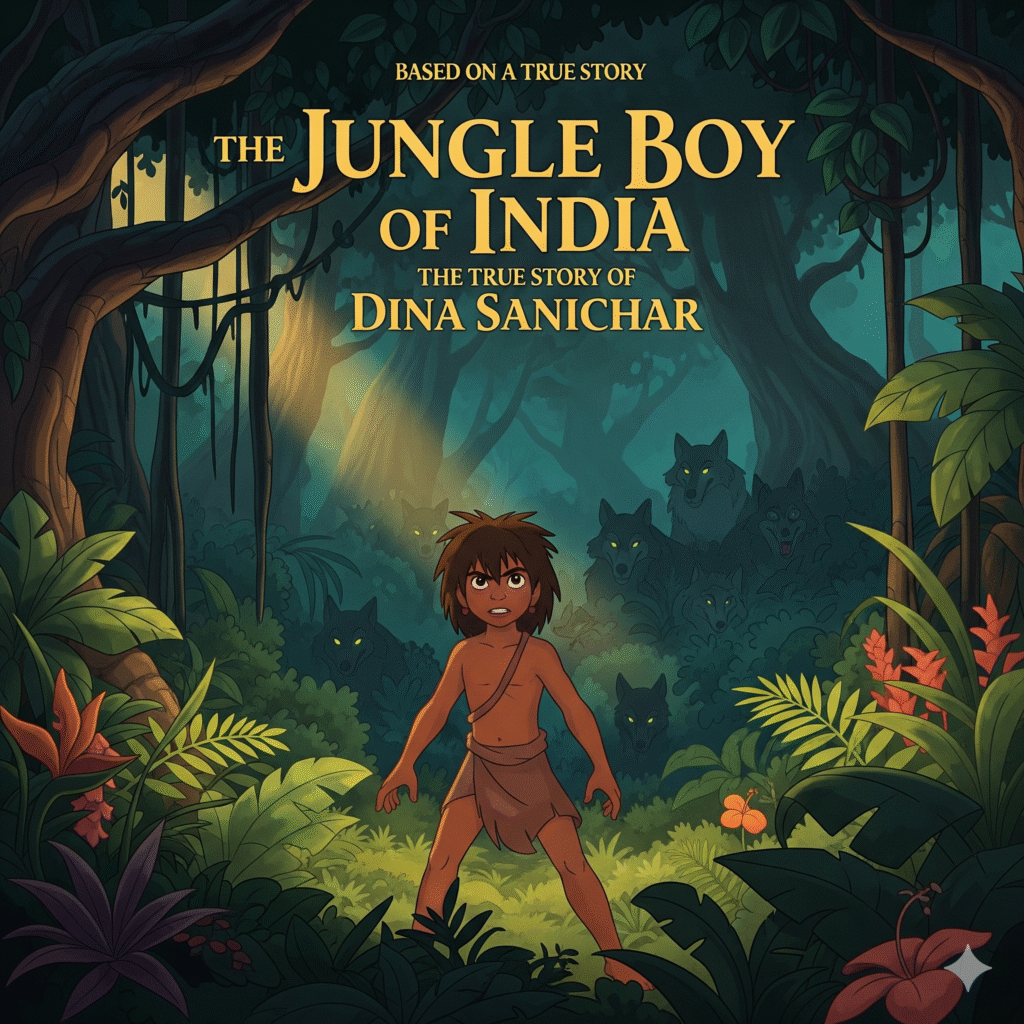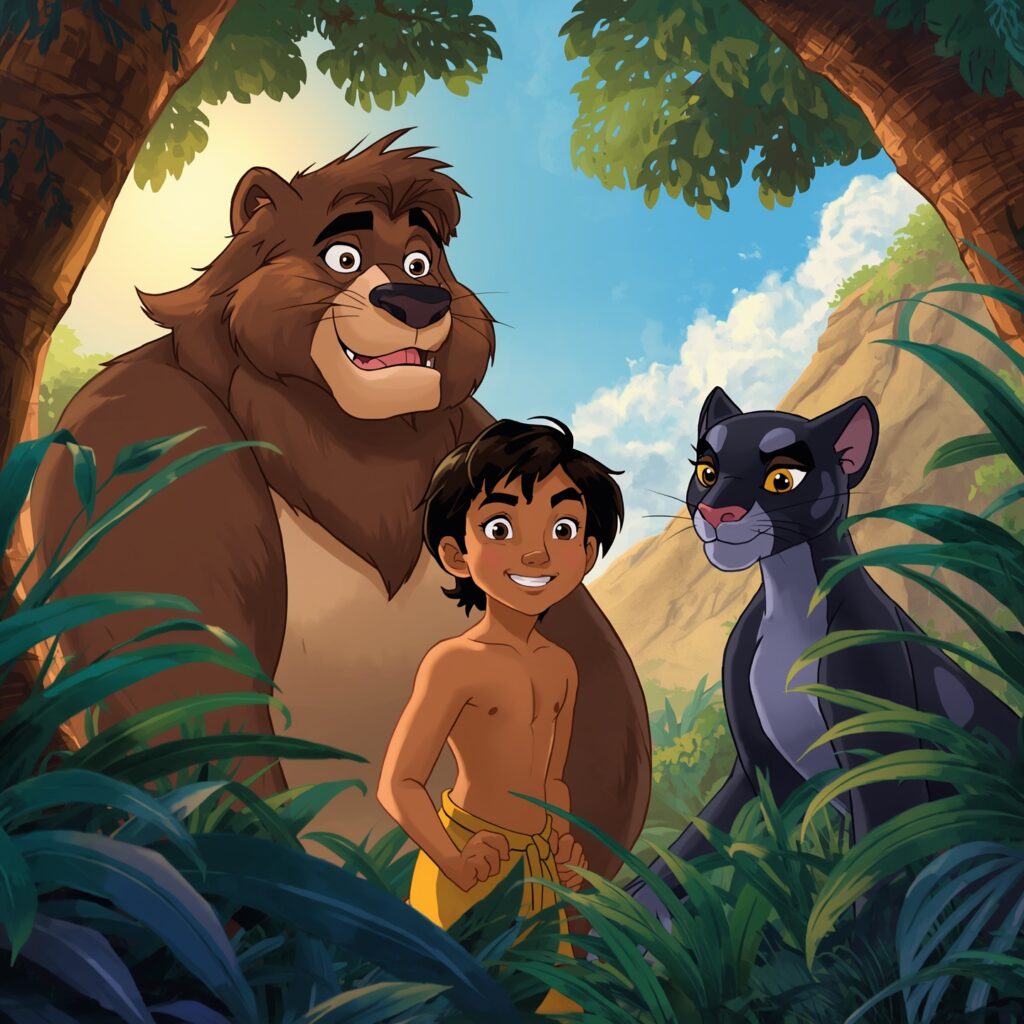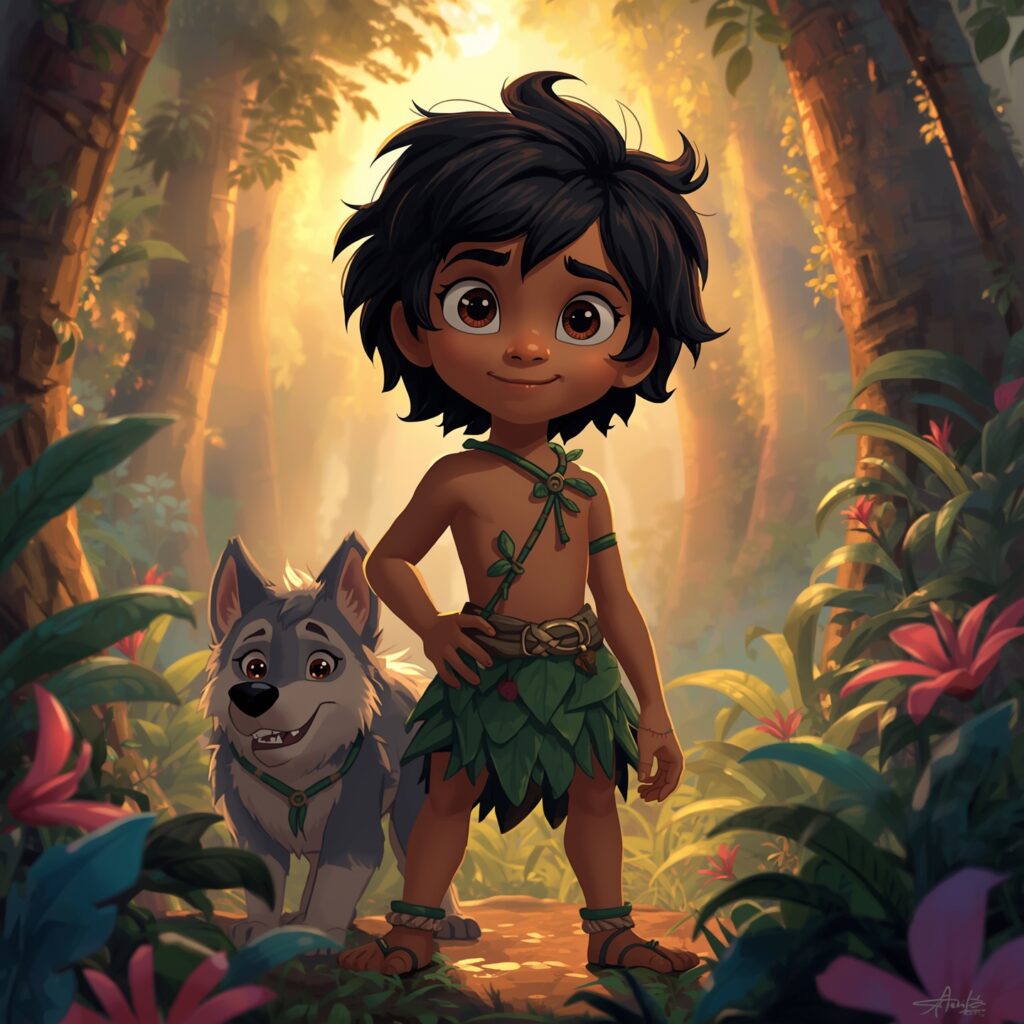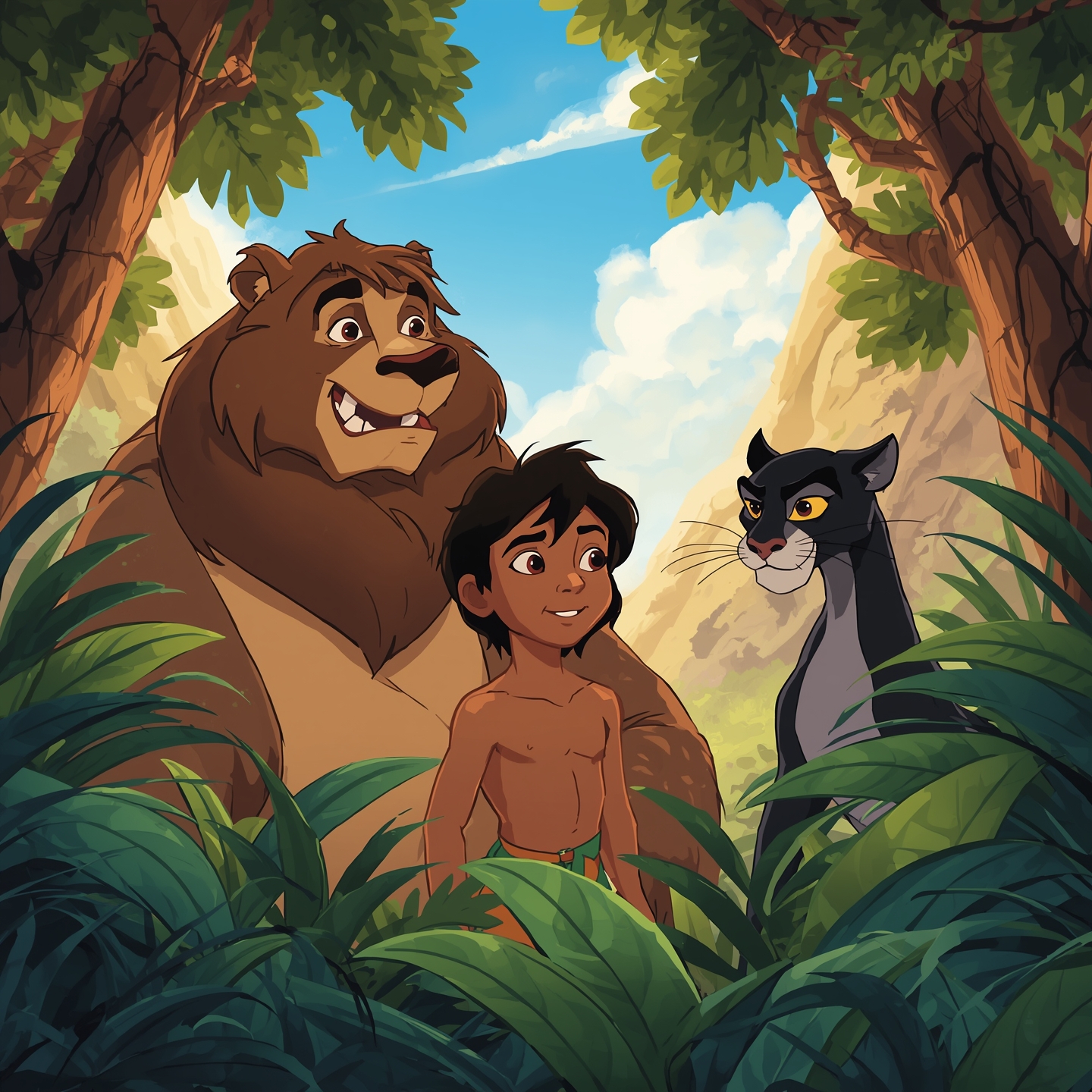“The Jungle Book” is more than just a story it’s a legendary collection of adventures set deep in the heart of the Indian jungle. Originally written by Rudyard Kipling in 1894, this timeless tale has captivated generations of readers and viewers with its thrilling mix of wild animals, fierce friendships, and powerful life lessons.
Whether through the original book, Disney adaptations, or modern retellings, The Jungle Book remains a beloved classic for both children and adults around the world.
The Heart of the Story: Meet Mowgli, the Man Cub

At the center of The Jungle Book is Mowgli, a young boy raised by wolves in the jungle after being found abandoned as a baby. Instead of fearing the wild, Mowgli embraces it with help from his animal friends who teach him how to survive, think, and love.
“He is no ordinary boy. He is the jungle’s child.”
Raised by Mother Wolf and Father Wolf, Mowgli learns the Law of the Jungle, and faces challenges that test his courage, intelligence, and sense of belonging.
🐻 Unforgettable Characters That Bring the Jungle to Life
Each character in The Jungle Book has its own charm, role, and symbolic meaning:
- Baloo the Bear The easygoing, lovable teacher who teaches Mowgli the jungle laws and the value of fun, friendship, and freedom.
- Bagheera the Panther The wise and protective mentor who understands both the jungle and the world of men.
- Shere Khan the Tiger The powerful and cunning villain who despises humans and wants Mowgli gone.
- Kaa the Python The hypnotic snake whose loyalty wavers but often plays a crucial role in the jungle’s balance.
- The Wolf Pack Mowgli’s adoptive family who raises him with loyalty and love.
These characters are more than just animals they’re metaphors for different sides of human nature: strength, fear, wisdom, protection, and rebellion.
Themes and Life Lessons in The Jungle Book
What makes The Jungle Book so powerful is that it’s more than an adventure story book. It’s a moral journey filled with deep lessons:
- The importance of identity Mowgli struggles to understand whether he belongs in the jungle or the human world.
- Loyalty and friendship The bond between Mowgli and his animal friends shows the meaning of trust and selflessness.
- Courage in the face of danger Mowgli doesn’t run from Shere Khan. He faces him with wit and bravery.
- Living in harmony with nature The jungle follows its own law, and those who respect it survive and thrive.
From Page to Screen: Jungle Book Adaptations
The story has been adapted countless times, with some of the most famous being:
- Disney’s 1967 animated film With songs like Bare Necessities, this version brought humor and heart to a global audience.
- The Jungle Book (2016) A live-action/CGI remake that explored deeper emotions and stunning visual storytelling.
- Mowgli: Legend of the Jungle (2018) A darker retelling that focuses more on Mowgli’s identity crisis and place in both worlds.
Each version gives a unique spin to Kipling’s original tale while keeping its core message alive.
Jungle True Story
1. The Jungle Boy of India: The True Story of Dina Sanichar
Location: Uttar Pradesh, India
Time: 1867

In the dense jungles of India, a group of hunters stumbled upon a strange sight in a cave a wild boy living among wolves. The boy, around six years old, ran on all fours, growled like a wolf, and ate raw meat. His name was Dina Sanichar, and he would later be called The Real Jungle Book Boy.
Dina was brought to an orphanage in Agra, but the world of humans terrified him. He never learned to speak, and always preferred the company of animals. He tore up clothes, refused to eat cooked food, and only responded to howling. Over time, he began to walk upright but never fully adjusted to human life.
Though many believed he inspired Rudyard Kipling’s Mowgli, Dina’s life was more tragic than heroic. He died in his thirties due to illness. His story is both heartbreaking and mysterious raising questions about identity, nature, and whether love alone can transform the wildest souls.
True Theme: What makes us human the mind, the environment, or the heart?
2. The Man-Eater of Champawat: The Tigress That Terrified a Nation
Location: Champawat, India & Nepal
Time: Early 1900s

In the foothills of the Himalayas, villagers lived in terror of a Bengal tigress that had developed a terrifying habit it hunted humans. Over 436 people had fallen prey to the predator, earning her the name: The Man-Eater of Champawat.
No one could stop her until Jim Corbett, a young British-Indian hunter and naturalist, took up the challenge. Corbett tracked her across dense jungle, using his knowledge of animal behavior and deep silence. It took weeks, but eventually, in a dramatic encounter near a ravine, Corbett shot the tigress down saving thousands.
But instead of celebrating victory, Corbett dug deeper. He found that the tigress’s teeth were broken injuries likely caused by bullets or traps meaning she couldn’t hunt her usual prey. Humans became her only chance for survival.
Corbett later dedicated his life to protecting tigers and jungles. His transformation from hunter to conservationist became the legacy of India’s tiger protection movement.
True Theme: Even monsters may be victims of circumstance.
3. Lost in the Amazon : Juliane Koepcke’s Unbelievable Survival
Location: Amazon Rainforest, Peru
Time: 1971
Seventeen-year-old Juliane Koepcke boarded a flight with her mother to spend Christmas in the jungle research station her parents ran. But tragedy struck when lightning hit the plane mid-air. Juliane, still strapped to her seat, fell 10,000 feet into the Amazon jungle.
Miraculously, she survived the fall with a broken collarbone and a swollen eye. Alone, in the vast, snake-filled forest, she had no map, no food, and only one sandal.
Juliane followed a stream, recalling her father’s jungle teachings: water leads to people. For 11 days, she wandered barefoot, drinking dirty water and eating sweets from her fallen backpack. She swatted away insects, avoided crocodiles, and pushed through thick foliage.
Eventually, she found a boat near a jungle hut, and was rescued by forest workers. Her survival is still considered one of the greatest jungle miracles ever recorded.
True Theme: Nature tests, but it also teaches and sometimes, it saves.
4. Dian Fossey: The Woman Who Lived with Gorillas
Location: Virunga Mountains, Rwanda
Time: 1960s–1980s

Dian Fossey was not a zoologist by training, but she became one of the most important voices in wildlife conservation. In the mist-covered rainforests of Rwanda, she studied and lived among mountain gorillas an endangered species facing extinction due to poaching.
Unlike most researchers, Fossey didn’t just observe she befriended the gorillas, giving them names and even mimicking their behavior to gain trust. Gorillas like Digit, Peanuts, and Uncle Bert became part of her life. They played with her, touched her face, and even let their babies climb into her lap.
But poaching was growing worse. In 1977, Digit, her favorite gorilla, was killed by poachers. Devastated, Fossey launched a personal war against illegal hunting, setting up patrols and removing traps.
Her activism earned her enemies. In 1985, Dian was found murdered in her jungle cabin. Her death remains unsolved but her legacy inspired generations to fight for wildlife.
True Theme: To protect the wild, sometimes you must live wild.
5. The Lost Tribe of the Amazon: The Uncontacted People
Location: Brazilian Amazon
Time: Ongoing Discovery (2000s–Present)

Deep in the Amazon rainforest live tribes that have never made contact with the outside world. One such tribe was spotted from a plane in the early 2000s naked men with spears, red body paint, and thatched huts in the middle of unbroken jungle.
Photos of them shocked the world. Who were these people? How did they live?
These uncontacted tribes know the jungle like the back of their hands living entirely off the land. They hunt with blowpipes, collect medicinal herbs, and move seasonally to avoid outsiders. Modern researchers keep their distance to avoid spreading disease.
But the jungle is vanishing. Illegal loggers and miners are pushing in, threatening their homes. The story of these tribes is a real-life mystery still unfolding.
They are not fiction. They are the last echoes of ancient ways, reminding us that some stories are still being written without phones, books, or cameras.
True Theme: The jungle still holds secrets and people beyond our understanding.
Mowgli Jungle Book Story
1. Mowgli’s First Roar: The Beginning of the Jungle Boy
When the monsoon season roared across the Indian jungle, lightning cracked the skies like a warning. Deep within the Seeonee hills, a panther named Bagheera silently prowled under dripping leaves when he heard the strange cry of a human baby. Wrapped in a torn cloth and lying alone in a hollow of a fallen tree, the baby boy was utterly defenseless.
Bagheera knew the jungle was no place for a man-cub, but something stirred in his heart. He gently lifted the child in his mouth and carried him to Mother and Father Wolf, whose den was warm and safe. The wolves, though surprised, saw something fierce in the boy’s eyes and chose to raise him as their own. They named him Mowgli.
But not all animals were pleased.
Shere Khan, the tiger, burned with hatred. He claimed the child as his prey and warned the wolf pack to surrender him. But Akela, the wise old leader, stood tall. Bagheera, with the price of a fresh-killed bull, bought Mowgli’s freedom. The pack agreed to keep him marking the beginning of a wild, glorious, and dangerous life.
2. Mowgli and the Bandar-log: The Monkeys of Madness
Mowgli’s days in the jungle were full of learning. Baloo, the bear, taught him jungle laws how to be respectful, how to track, how to listen. But the jungle wasn’t just filled with rules it was also filled with chaos.
One day, while exploring, Mowgli was kidnapped by the Bandar-log the lawless monkey tribe. They laughed wildly and carried him high above the treetops, swinging from branch to branch toward the crumbling ruins of an ancient city.
Mowgli’s cries were heard by Bagheera and Baloo, who rushed to rescue him. But the monkeys outnumbered them. That’s when Kaa, the massive python, slithered silently into the ruins. With hypnotic eyes and slow, deadly grace, Kaa mesmerized the monkeys, causing chaos and fear. The monkeys fled, leaving Mowgli safe.
Though Kaa was feared, Mowgli thanked him earning not only the snake’s respect but also understanding that in the jungle, even danger can be an ally.
3. The Return of Shere Khan: The Man-Cub’s Stand
As Mowgli grew, so did Shere Khan’s hatred. The tiger never forgot the insult of being denied his prey. One night, by the Wainganga River, Mowgli overheard the wolves whispering: Shere Khan planned to return and kill Akela. The wolf pack was weakening, and the tiger’s lies were poisoning their minds.
Furious and heartbroken, Mowgli knew he had to act. He went to the village of men, stealing a burning branch a weapon no animal dared approach: fire, the Red Flower.
Returning to Council Rock, Mowgli stood before Shere Khan and the disloyal wolves. His eyes burned like the flames in his hand. With a single motion, he waved fire toward the tiger, forcing him to flee. But the damage was done. The pack had doubted him.
Feeling no longer welcome, Mowgli said goodbye to his wolf family and walked alone into the village of men, to find where he truly belonged.
4. Mowgli Among Humans: The Silent Village
Mowgli entered the human village like a stranger from another world. A kind woman named Messua took him in, believing him to be her long-lost son. Mowgli tried to adjust wearing clothes, herding cattle, learning words. But it all felt unnatural.
The village feared him. Children mocked him. The priest called him cursed. Mowgli never knelt, never lied, and never feared. He kept company with the cattle and spoke with Grey Brother, his wolf sibling, who visited him at night.
One day, Shere Khan returned luring Mowgli’s bull far into the jungle. But Mowgli was ready. With Grey Brother’s help, he led the herd in a thunderous stampede. The ground shook, the tiger roared, and at last under the crushing weight Shere Khan fell.
Mowgli skinned the tiger and brought the pelt to Council Rock. But even with victory, his heart ached. He belonged to both worlds and neither.
5. The Jungle Farewell: Mowgli’s Final Choice
Years passed. Mowgli grew stronger, wiser, and more distant from the wolves. He walked like a man but heard like a beast. One day, Bagheera said, “The jungle changes. Your time here ends.”
Mowgli didn’t protest. He climbed to Council Rock one final time and looked over the land that had raised him. Below, the rivers coiled like snakes. The trees whispered stories of his youth. The wind carried Baloo’s distant humming.
He said farewell to Akela’s grave, nodded at the jungle’s edge, and walked back toward the village. Not as a lost boy, not as a man-cub but as Mowgli, son of both fire and forest.
In his heart, the jungle would never die.
Why The Jungle Book Story Still Matters Today
In a fast-paced, tech-driven world, The Jungle Book reminds us of:
- The beauty of nature
- The importance of family whether blood or chosen
- The journey of self-discovery
- The strength that comes from compassion
It’s a story for every age whether you’re a child discovering it for the first time, or an adult re-reading it with new understanding.
Conclusion: More Than a Jungle Adventure
The Jungle Book is not just a children’s tale it’s a profound story about what it means to grow up, to fight for your place in the world, and to find family where you least expect it.
So whether you’re reading the book, watching the movie, or exploring retellings, know this:
The jungle is not just a place.
It’s a test, a teacher, and a treasure.
For more bedtime stories, check our Adventure Stories Collection

